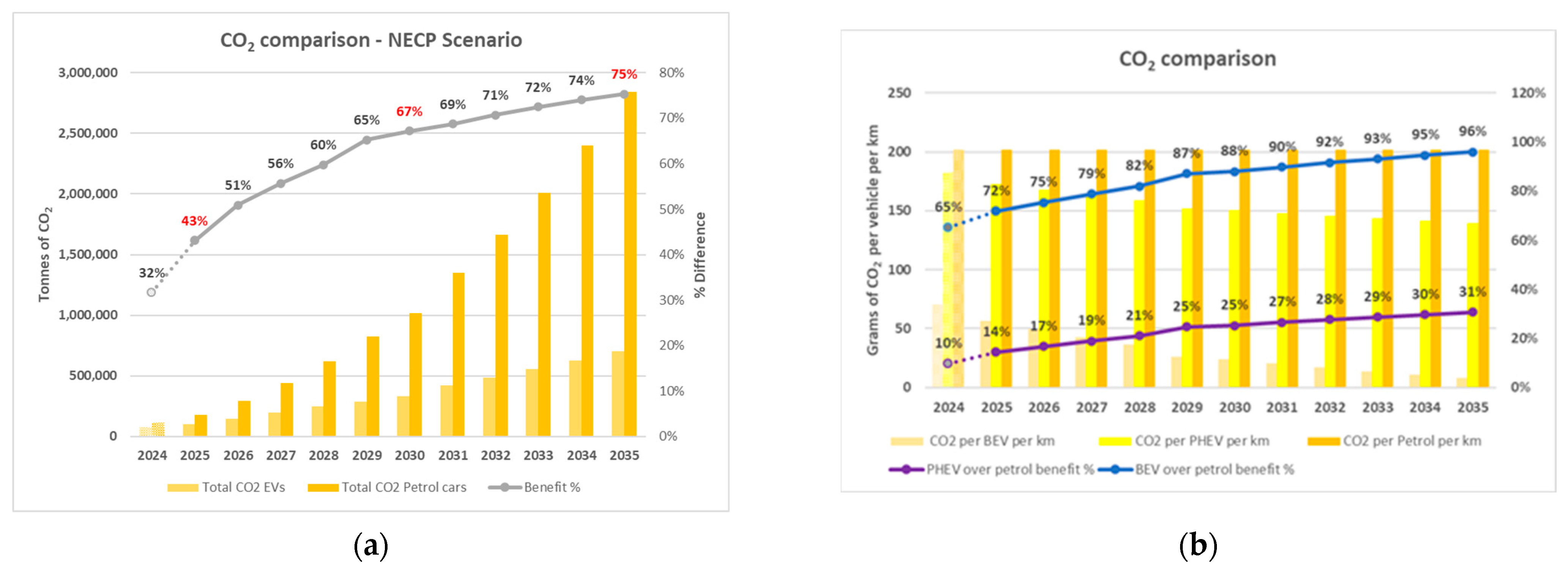Electrification of Transportation in Greece: A Study on CO2 Emission Reduction Potential and Energy Mix Implications †
Abstract
1. Introduction
2. Methodology
3. Results and Discussion
4. Conclusions
Author Contributions
Funding
Institutional Review Board Statement
Informed Consent Statement
Data Availability Statement
Conflicts of Interest
References
- European Commission. Sustainable and Smart Mobility Strategy: Putting European Transport on Track for the Future; Publications Office of the European Union: Luxembourg, 2020; Available online: https://eur-lex.europa.eu/legal-content/EN/TXT/?uri=CELEX%3A52020DC0789 (accessed on 28 May 2025).
- Rokicki, T.; Bórawski, P.; Bełdycka-Bórawska, A.; Zak, A.; Koszela, G. Development of Electromobility in European Union Countries under COVID-19 Conditions. Energies 2022, 15, 9. [Google Scholar] [CrossRef]
- International Energy Agency (IEA). Global EV Outlook 2024; International Energy Agency: Paris, France, 2024; Available online: https://www.iea.org/reports/global-ev-outlook-2024 (accessed on 28 May 2025).
- International Transport Forum (ITF). Advancing Sustainable Mobility in Greece: Promoting the Uptake of Electric Vehicles; International Transport Forum Policy Paper; OECD Publishing: Paris, France, 2024; Available online: https://www.itf-oecd.org/advancing-sustainable-mobility-greece-electric-vehicles-summary (accessed on 2 May 2025).
- Buekers, J.; Van Holderbeke, M.; Bierkens, J.; Panis, L. Health and environmental benefits related to electric vehicle introduction in EU countries. Transp. Res. Part D Transp. Environ. 2014, 33, 26–38. [Google Scholar] [CrossRef]
- Rokicki, T.; Koszela, G.; Ochnio, L.; Wojtczuk, K.; Ratajczak, M.; Szczepaniuk, H.; Michalski, K.; Bórawski, P.; Bełdycka-Bórawska, A. Diversity and Changes in Energy Consumption by Transport in EU Countries. Energies 2021, 14, 5414. [Google Scholar] [CrossRef]
- Buberger, J.; Kersten, A.; Kuder, M.; Eckerle, R.; Weyh, T.; Thiringer, T. Total CO2-equivalent life-cycle emissions from commercially available passenger cars. Renew. Sustain. Energy Rev. 2022, 159, 112158. [Google Scholar] [CrossRef]
- Spyropoulos, G.; Nastos, P.T.; Moustris, K.P.; Chalvatzis, K.J. Transportation and Air Quality Perspectives and Projections in a Mediterranean Country, the Case of Greece. Land 2022, 11, 152. [Google Scholar] [CrossRef]
- ADMIE. Monthly Energy Reports | IPTO; ADMIE: Athens, Greece, 2024; Available online: https://www.admie.gr/en/market/reports/monthly-energy-balance (accessed on 7 March 2025).
- Hellenic Ministry of Environment and Energy. National Energy and Climate Plan; Hellenic Ministry of Environment and Energy: Athens, Greece, 2024; Available online: https://commission.europa.eu/publications/greece-final-updated-necp-2021-2030-submitted-2025_en (accessed on 4 February 2025).
- Hellenic Ministry of Environment and Energy. National Electromobility Plan; Hellenic Ministry of Environment and Energy: Athens, Greece, 2023; Available online: https://shorturl.at/5xAJF (accessed on 2 April 2025).
- Daze. Vehicles on European Roads: Analysis of ACEA 2024 Report; Daze: Milan, Italy, 2024; Available online: https://www.daze.eu/en/blog/vehicles-european-roads-2023 (accessed on 26 April 2025).
- Harper, C.D.; Hendrickson, C.T.; Mangones, S.; Samaras, C. Estimating potential increases in travel with autonomous vehicles for the non-driving, elderly and people with travel-restrictive medical conditions. Transp. Res. Part C Emerg. Technol. 2016, 72, 1–9. [Google Scholar] [CrossRef]
- WANADA. Self-Driving Cars Will Be 75% of Global Market by 2035; WANADA: Washington, DC, USA, 2025; Available online: https://wanada.org/self-driving-cars-will-be-75-of-global-market-by-2035/ (accessed on 22 May 2025).
- Spritmonitor.de. Average Gasoline and Electricity Consumption of EVs and Petrol Passenger Cars; Spritmonitor.de. 2025. Available online: https://www.spritmonitor.de/en/ (accessed on 23 May 2025).
- Hao, X.; Yuan, Y.; Wang, H.; Sun, Y. Actual electricity utility factor of plug-in hybrid electric vehicles in typical Chinese cities considering charging pattern heterogeneity. World Electr. Veh. J. 2021, 12, 169. [Google Scholar] [CrossRef]
- European Environment Agency (EEA). Industrial Reporting Under the Industrial Emissions Directive 2010/75/EU and European Pollutant Release and Transfer Register Regulation (EC) No 166/2006; European Environment Agency: Copenhagen, Denmark, 2025. [Google Scholar] [CrossRef]
- PPC; Hellenic Ministry of Environment and Energy. Annual Report: Lignite Steam Power Plant Agios Dimitrios 2023; PPC and Hellenic Ministry of Environment and Energy: Athens, Greece, 2024; Available online: https://shorturl.at/DdAqR (accessed on 19 March 2025).
- PPC; Hellenic Ministry of Environment and Energy. Annual Report: Lignite Steam Power Plant Megalopoli 5 2023; PPC and Hellenic Ministry of Environment and Energy: Athens, Greece, 2024; Available online: https://shorturl.at/3xF43 (accessed on 19 March 2025).
- EMISIA. COPERT–Computer Programme to Calculate Emissions from Road Transport; EMISIA: Thessaloniki, Greece, 2025; Available online: https://copert.emisia.com/ (accessed on 26 May 2025).


Disclaimer/Publisher’s Note: The statements, opinions and data contained in all publications are solely those of the individual author(s) and contributor(s) and not of MDPI and/or the editor(s). MDPI and/or the editor(s) disclaim responsibility for any injury to people or property resulting from any ideas, methods, instructions or products referred to in the content. |
© 2025 by the authors. Licensee MDPI, Basel, Switzerland. This article is an open access article distributed under the terms and conditions of the Creative Commons Attribution (CC BY) license (https://creativecommons.org/licenses/by/4.0/).
Share and Cite
Spyropoulos, G.; Spyrakis, K.; Moustris, K.; Mavroulidis, M.; Touralia, I. Electrification of Transportation in Greece: A Study on CO2 Emission Reduction Potential and Energy Mix Implications. Environ. Earth Sci. Proc. 2025, 35, 38. https://doi.org/10.3390/eesp2025035038
Spyropoulos G, Spyrakis K, Moustris K, Mavroulidis M, Touralia I. Electrification of Transportation in Greece: A Study on CO2 Emission Reduction Potential and Energy Mix Implications. Environmental and Earth Sciences Proceedings. 2025; 35(1):38. https://doi.org/10.3390/eesp2025035038
Chicago/Turabian StyleSpyropoulos, Georgios, Konstantinos Spyrakis, Konstantinos Moustris, Michael Mavroulidis, and Irene Touralia. 2025. "Electrification of Transportation in Greece: A Study on CO2 Emission Reduction Potential and Energy Mix Implications" Environmental and Earth Sciences Proceedings 35, no. 1: 38. https://doi.org/10.3390/eesp2025035038
APA StyleSpyropoulos, G., Spyrakis, K., Moustris, K., Mavroulidis, M., & Touralia, I. (2025). Electrification of Transportation in Greece: A Study on CO2 Emission Reduction Potential and Energy Mix Implications. Environmental and Earth Sciences Proceedings, 35(1), 38. https://doi.org/10.3390/eesp2025035038







